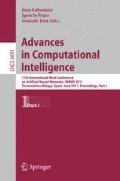Abstract
Anomalies in the oculomotor system are well known symptoms in patients with severe Spino Cerebellar Ataxia 2 form of autosomal dominant cerebellar ataxias (ADCA), including the main parameters used to describe saccadic movements. Also a combination of a pulse and step components constitutes an accepted model of the saccadic generation system, In the present work, Independent Component Analysis (ICA) is used to separate both components, revealing a significant difference in the time of the pulse component to reach its maximum value. This result suggests its use in order to obtain a classification tool to diagnose this disease. Five electro-oculographic records of patients of SCA2 ataxia and five control subjects were processed with the ICA based algorithm with this objective.
Access this chapter
Tax calculation will be finalised at checkout
Purchases are for personal use only
Preview
Unable to display preview. Download preview PDF.
References
Velázquez, L.: Ataxia espino cerebelosa tipo 2. Principales aspectos neurofisiológicos en el diagnóstico, pronóstico y evaluación de la enfermedad. Ediciones Holguín (2006)
Auburger, G., Orozco Diaz, G., Ferreira Capote, R., Gispert Sanchez, S., Paradoa Perez, M., Estrada del Cueto, M., et al.: Autosomal dominant ataxia: Genetic evidence for locus heterogeneity from a Cuban founder-effect population. American Journal of Human Genetics 46(6), 1163–1177 (1990)
Orozco, G., Estrada, R., Perry, T.L., Araña, J., Fernandez, R., Gonzalez-Quevedo, A., et al.: Dominantly inherited olivopontocerebellar atrophy from eastern Cuba: Clinical, neuropathological, and biochemical findings. Journal of the Neurological Sciences 93(1), 37–50 (1989)
Engel, K.C., Anderson, J.H., Gomez, C.M., Soechting, J.: Deficits in ocular and manual tracking due to episodic ataxia type 2. Movement Disorders 19(7), 778–787 (2004)
Schöls, L., Linnemann, C., Globas, C.: Electrophysiology in spinocerebellar ataxias: Spread of disease and characteristic findings. The Cerebellum 7(2), 198–203 (2008)
Wadia, N., Pang, J., Desai, J., Mankodi, A., Desai, M., Chamberlain, S.: A clinicogenetic analysis of six Indian spinocerebellar ataxia (SCA2) pedigrees. The significance of slow saccades in diagnosis. Brain 121(12), 2341–2355 (1998)
Seifried C., Velázquez-Pérez L,, Santos-Falcón N., Abele M., Ziemann U., Almaguer L.E., et al.: :Saccade velocity as a surrogate disease marker in spinocerebellar ataxia type 2 [Internet] (2005), http://www.scopus.com/scopus/inward/record.url?eid=2-s2.0-22144471158&partnerID=40&rel=R8.2.0 (cited November13, 2008)
Velázquez-Pérez, L., Seifried, C., Santos-Falcón, N., Abele, M., Ziemann, U., Almaguer, L.E., et al.: Saccade velocity is controlled by polyglutamine size in spinocerebellar ataxia 2. Annals of Neurology 56(3), 444–447 (2004)
Velázquez-Pérez, L., Almaguer-Mederos, L., Santos-Falcón, N., Hechavarría-Pupo, R., Sánchez-Cruz, G., Paneque-Herrera, M.: Spinocerebellar ataxia type 2 in Cuba. A study of the electrophysiological phenotype and its correlation with clinical and molecular variables. Revista de Neurologia 33(12), 1129–1136 (2001)
Robinson, D.A.: The mechanics of human saccadic eye movement. J. Physiol. 174(2), 245–264 (1964)
Optican, L.M., Robinson, D.: Cerebellar-dependent adaptive control of primate saccadic system. J. Neurophysiol. 44(6), 1058–1076 (1980)
Hyvärinen, A., Karhunen, J., Oja, E.: Independent component analysis. John Wiley and Sons, Chichester (2001)
James, C.J., Hesse, C.W.: Independent component analysis for biomedical signals. Physiol. Meas., http://iopscience.iop.org/0967-3334/26/1/R02 (cited 10:19:31)
Jung, T.-P., Makeig, S., Lee, T.-W., McKeown, M.J., Brown, G., Sejnowski, T.J.: Independent Component Analysis of Biomedical Signals
Alvarez, T.L., Daftari, A., Semmlow, J.L.: Independent Component Analysis of Divergence Eye Movements. In: Proceedings of 2nd International IEEE EMBS Conference on Neural Engineering, pp. 608–611 (2005)
Gayed, B.A., Alvarez, T.L., Daftari, A., Semmlow, J.L., Pedrono, C.: Independent component analysis reveals transient component of divergence varies with initial position [Internet]. In: Proceedings of the Northeast Conference Bioengineering (2005), http://www.scopus.com/inward/record.url?eid=2-s2.0-28444454426&partnerID=40&md5=c8fca8b6a42d1f90ac5d7f9b20ed42ab (cited April 21, 2010)
Chen, Y.-F., Chen, T., Semmlow, J.L.: Decomposition of Control Signals for Saccade and Vergence Eye Movements Using Independent Component Analysis. Journal of Medical and Biological Engineering 24(1), 23–28 (2004)
Lin, H.-H., Chen, Y.-F., Chen, T., Lee, Y.-Y.: Decomposition of saccadic pulse and step components by independent component analysis [Internet]. In: Proceedings of the International Conference on Mathematics and Engineering Techniques in Medicine and Biological Sciences, METMBS 2004, pp. 124–128 (2004), http://www.scopus.com/scopus/inward/record.url?eid=2-s2.0-11144264106&partnerID=40 (cited December 3, 2008)
Bell, A.J., Sejnowski, T.J.: An information-maximization approach to blind separation and blind deconvolution. Nerual Computation 7, 1129–1159 (1995)
Author information
Authors and Affiliations
Editor information
Editors and Affiliations
Rights and permissions
Copyright information
© 2011 Springer-Verlag Berlin Heidelberg
About this paper
Cite this paper
García, R.V. et al. (2011). Pulse Component Modification Detection in Spino Cerebellar Ataxia 2 Using ICA. In: Cabestany, J., Rojas, I., Joya, G. (eds) Advances in Computational Intelligence. IWANN 2011. Lecture Notes in Computer Science, vol 6691. Springer, Berlin, Heidelberg. https://doi.org/10.1007/978-3-642-21501-8_40
Download citation
DOI: https://doi.org/10.1007/978-3-642-21501-8_40
Publisher Name: Springer, Berlin, Heidelberg
Print ISBN: 978-3-642-21500-1
Online ISBN: 978-3-642-21501-8
eBook Packages: Computer ScienceComputer Science (R0)

